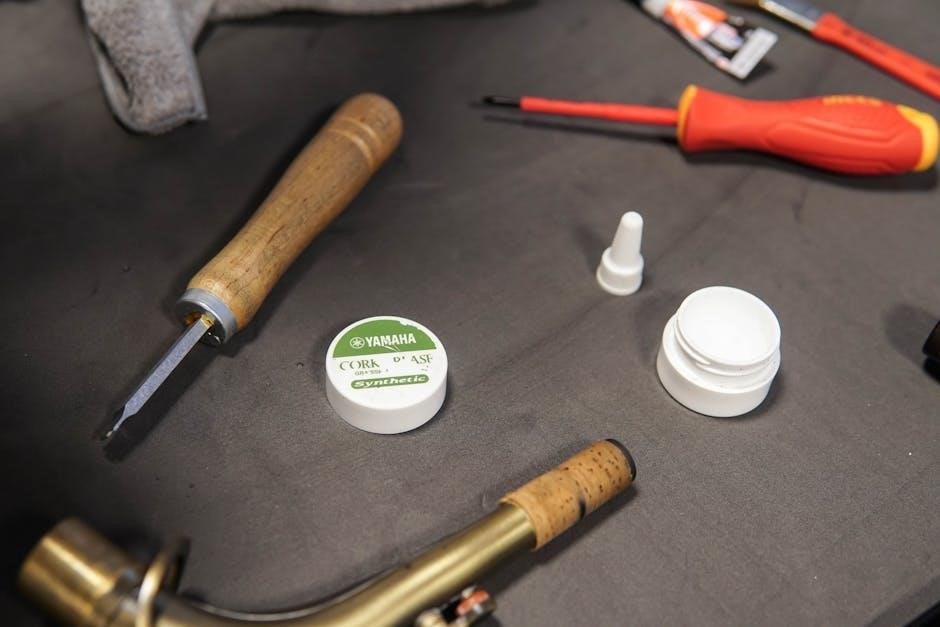yamaha tf5 manual

The Yamaha TF5 manual is a comprehensive guide designed to help users maximize the potential of their digital mixing console․ It covers features‚ operations‚ and setup‚ ensuring optimal performance for professionals and newcomers alike․
1․1 Overview of the Yamaha TF5 Digital Mixing Console
The Yamaha TF5 is a professional digital mixing console designed for live sound‚ installation‚ and recording applications․ Part of the TF series‚ it offers 32+1‚ 24‚ or 16 channels‚ depending on the model‚ with a intuitive touchscreen interface and motorized faders․ The TF5 combines Yamaha’s renowned D-PRE preamps with advanced digital processing‚ ensuring high-quality audio reproduction․ Its compact design and robust feature set make it ideal for engineers seeking flexibility and reliability in various mixing environments․
1․2 Importance of the Manual for Optimal Usage
The Yamaha TF5 manual is essential for unlocking the full potential of the console․ It provides detailed instructions for understanding and utilizing advanced features‚ ensuring proper setup‚ and troubleshooting common issues․ By following the manual‚ users can optimize their mixing experience‚ whether in live sound‚ recording‚ or installation environments․ The guide is particularly valuable for newcomers‚ offering clear explanations of complex functions and best practices for achieving professional-grade audio quality․ Regularly updating to the latest manual version ensures access to the most current features and improvements․
1․3 Key Features of the Yamaha TF5
The Yamaha TF5 is equipped with a 7-inch color touch screen for intuitive control and a 16-fader configuration for hands-on mixing․ It features 40 input channels‚ 20 aux buses‚ and 8 DCA groups for flexible routing․ The console includes Yamaha’s renowned D-PRE preamps for high-quality sound reproduction․ Additionally‚ it supports Dante networking for seamless audio integration and offers advanced effects like Dan Dugan automixer for professional live sound applications․ These features make the TF5 a versatile and powerful tool for live sound‚ broadcasting‚ and installations․

Structure of the Yamaha TF5 Manual
The manual is organized into clear chapters‚ starting with an introduction‚ followed by detailed sections on operation‚ advanced features‚ troubleshooting‚ and maintenance․ Appendices and visual aids are included for easy reference‚ ensuring users can navigate and understand the console’s functionalities efficiently․
2․1 Table of Contents and Navigation
2․2 Conventions Used in the Manual
The Yamaha TF5 manual employs specific conventions to ensure clarity and consistency․ Terms are italicized when referring to menu items or screen labels‚ while bold text highlights physical buttons and controls․ Warning icons and cautionary notes are emphasized to draw attention to critical safety or operational details․ Additionally‚ the manual uses color-coded diagrams and numbered lists to simplify complex procedures․ Technical terms are defined upon first use‚ and cross-references are provided to guide users to related sections․ These conventions enhance readability and help users navigate the manual efficiently․
2․3 Symbols and Terminology Explained
The Yamaha TF5 manual uses standardized symbols and terminology to convey information clearly․ Warning signs‚ such as triangles‚ indicate potential hazards or important notes․ Checkmarks and X symbols denote correct or incorrect actions․ Gear icons represent settings or configurations․ Terms like “channel‚” “scene‚” and “DCA” are defined to ensure understanding․ Abbreviations like “MIDI” and “Dante” are explained in context․ This consistent use of symbols and terminology helps users quickly grasp complex concepts and navigate the manual effectively without confusion․

Pre-Operation Checklist
Ensure the Yamaha TF5 is properly powered‚ all connections are secure‚ and firmware is updated․ Conduct a sound check to verify audio integrity before use․
3․1 System Requirements and Compatibility
The Yamaha TF5 is compatible with Windows (10/11) and macOS (10․15 or later) for seamless integration with computers․ It requires a minimum of an Intel Core i5 or equivalent processor and 8GB RAM for optimal performance․ The console supports USB 2․0/3․0 interfaces and works with major DAWs like Cubase‚ Logic Pro‚ and Ableton Live․ Ensure your system meets these requirements for smooth operation and to take full advantage of the TF5’s features․ Proper compatibility ensures reliable performance during live and studio applications․
3․2 Safety Precautions Before Use
Before using the Yamaha TF5‚ ensure the area is clear of flammable materials and liquids․ Avoid exposing the console to extreme temperatures or humidity․ Never touch electrical components with wet hands․ Use only the provided power cable and avoid overloading outlets․ Keep the console away from direct sunlight and ensure proper ventilation to prevent overheating․ Follow all local electrical regulations and guidelines․ Read the manual thoroughly before operation to understand proper usage and safety measures․
3․3 Firmware Updates and Latest Specifications
Regularly check Yamaha’s official website for the latest firmware updates to ensure optimal performance․ Updates often include bug fixes‚ new features‚ and compatibility improvements․ Use Yamaha-provided tools for firmware installation to avoid corruption․ Always back up your settings before updating․ Ensure the console is connected to a computer via a compatible USB port․ After installation‚ verify the firmware version matches the latest release․ Refer to the manual for detailed update instructions․ Updating ensures the Yamaha TF5 operates with the newest features and enhancements․
- Visit Yamaha’s support page for updates․
- Use only approved update methods․
- Ensure stable power during updates․

Installation and Setup
Proper installation ensures optimal performance․ Mount the console securely‚ connect peripherals‚ and configure settings․ Follow manual guidelines for placement‚ wiring‚ and initial setup․
- Ensure stable placement for durability․
- Connect cables correctly to avoid damage․
- Configure settings according to user needs․
4․1 Mounting and Placement Options
Proper mounting and placement are crucial for optimal performance and longevity․ The Yamaha TF5 can be installed in various setups‚ including fixed installations‚ portable configurations‚ or rack-mounted solutions․ Ensure the console is placed on a stable‚ flat surface‚ away from direct sunlight and moisture․ For rack mounting‚ use Yamaha-approved brackets to maintain proper ventilation and access to controls․ Consider ergonomic placement for comfortable operation‚ ensuring easy access to faders‚ knobs‚ and the touchscreen․ Always follow the manual’s guidelines to avoid damage and ensure reliable operation․
4․2 Connecting Peripherals and Accessories
Connecting peripherals and accessories to the Yamaha TF5 is straightforward but requires attention to detail․ Use the USB ports for connecting external storage‚ MIDI controllers‚ or computers․ The console also features XLR‚ TRS‚ and RCA inputs for audio sources․ Ensure all cables are securely plugged in and compatible with the respective ports․ Refer to the manual for specific connection diagrams and guidelines․ Use Yamaha-approved adapters and cables to maintain signal integrity and prevent damage․ Properly label and organize connections for easy identification and troubleshooting during live performances or recordings․
4․3 Initial Setup and Configuration
After connecting peripherals‚ proceed with the initial setup and configuration of the Yamaha TF5․ Power on the console and follow the on-screen prompts to select your language and preferences․ Calibrate the touchscreen for accurate operation․ Perform a basic sound check to ensure all inputs and outputs are functioning correctly․ Update the firmware if necessary‚ as outlined in the manual․ Configure user profiles and customize the layout to suit your workflow․ Save your settings to ensure consistency across sessions․ Refer to the manual for detailed steps to optimize your setup for specific applications or environments․

Basic Operation of the Yamaha TF5
The Yamaha TF5’s basic operation involves powering on‚ navigating the intuitive interface‚ and adjusting levels․ Use the touch screen to access channels‚ effects‚ and routing․ Presets simplify workflows for quick setup and consistent sound quality across performances․ Ensure all connections are secure before operation for optimal functionality․ Refer to the manual for step-by-step guidance on essential functions and troubleshooting common operational issues․ Regular updates ensure the console stays performant and feature-rich․ Proper care extends its lifespan and maintains reliability during live and studio applications․
5․1 Powering On and Off the Console
To power on the Yamaha TF5‚ locate the power switch on the rear panel and press and hold it until the power LED illuminates․ The console will boot up‚ displaying the home screen․ For shutdown‚ press and hold the same switch until the LED turns off․ Ensure all audio signals are stopped before powering off to prevent unexpected noise․ Always wait for the system to complete its shutdown process․ Keep the console unplugged during lightning storms to avoid damage from power surges․ Refer to the manual for detailed power management guidelines․
5․2 Navigating the Control Surface
Navigating the Yamaha TF5’s control surface is intuitive‚ with logical layout and responsive controls․ The 16-fader layout allows easy access to channels‚ while rotary knobs adjust levels and parameters․ The touch-sensitive screen simplifies menu navigation‚ enabling quick access to settings and effects․ Use the Home button to return to the main screen and Bank buttons to switch between channel groups․ The Scene buttons recall saved configurations‚ streamlining live performances and studio workflows․ Familiarize yourself with these controls to optimize mixing efficiency and creativity․
5․3 Understanding Basic Mixing Functions
Mastering basic mixing functions on the Yamaha TF5 ensures professional sound quality․ Start by adjusting input levels using the channel faders and gain knobs․ Apply EQ to shape tones‚ with high‚ mid‚ and low frequencies easily accessible․ Use the 1-Knob Compressor for dynamic control․ Add depth with built-in effects like reverb and delay․ Pan channels left or right for a balanced stereo image․ Utilize mute and solo buttons for isolating tracks․ These fundamental functions‚ combined with the TF5’s intuitive interface‚ allow for precise control and creative freedom during live or studio mixing sessions․

Advanced Features and Functions
Explore advanced features like touch screen control‚ custom fader banks‚ and DCA groups․ These tools streamline complex mixing tasks‚ enhancing workflow for live and studio applications․
6․1 Channel Strip Configuration and Customization
The Yamaha TF5 allows extensive customization of its channel strips‚ enabling users to tailor EQ‚ compression‚ and other parameters to suit specific audio sources․ The intuitive touch screen interface simplifies adjustments‚ while the premium rack provides access to additional processing tools․ Custom layouts can be saved and recalled for consistent mixes across different sessions․ This flexibility ensures that engineers can adapt the console to their workflow‚ enhancing creativity and efficiency during live performances and studio recordings․
6․2 Effects and Processing Options
The Yamaha TF5 offers a wide range of effects and processing tools to enhance your mixes․ With built-in effects like reverb‚ delay‚ and compression‚ users can apply professional-grade processing to individual channels or entire mixes․ The console also supports external effects via aux sends‚ allowing for greater flexibility․ Custom effects configurations can be saved and recalled‚ ensuring consistency across performances․ The intuitive interface makes it easy to adjust parameters‚ while the high-quality DSP ensures pristine sound reproduction‚ ideal for both live and studio applications․
6․3 Scene Management and Recall
The Yamaha TF5 features robust scene management‚ enabling users to save and recall specific mixing configurations․ Scenes store settings like fader levels‚ mutes‚ and effects‚ allowing seamless transitions during live performances․ The console supports up to 100 scenes‚ which can be organized and recalled instantly․ This feature is particularly useful for sound engineers managing complex shows with multiple setups․ Scenes can also be protected to prevent accidental overwrites․ The intuitive recall function ensures smooth operation‚ making it easier to handle dynamic live sound environments with precision and efficiency․

Connectivity and Integration
The Yamaha TF5 offers versatile connectivity options‚ including digital audio interfaces‚ MIDI control‚ and network integration‚ ensuring seamless operation in live and installed sound systems․
7․1 Audio Interface and Digital Connectivity
The Yamaha TF5 features robust audio interface options‚ including USB‚ ADAT‚ and S/PDIF‚ enabling high-quality digital connectivity․ These interfaces support up to 24-bit/192kHz resolution‚ ensuring pristine audio quality․ The USB connection allows direct integration with computers for DAW recording and playback‚ while ADAT and S/PDIF cater to compatibility with outboard gear and digital processors․ This versatility makes the TF5 ideal for live sound‚ studio recording‚ and installations‚ offering reliable and flexible digital connectivity solutions for diverse audio applications․
7․2 MIDI and Remote Control Capabilities
The Yamaha TF5 supports MIDI integration‚ enabling control of external MIDI-compatible devices and allowing the console to be controlled by MIDI controllers․ This enhances workflow by syncing with synthesizers‚ drum machines‚ and other MIDI gear․ Additionally‚ the TF5 offers remote control functionality through Yamaha’s dedicated software or apps‚ providing flexible operation from a computer or mobile device․ These features are ideal for live performances and studio setups‚ offering enhanced control and integration capabilities without overlapping with network or Dante-specific functionalities․
7․3 Network Integration and Dante Compatibility
The Yamaha TF5 seamlessly integrates with Dante audio networking‚ enabling high-quality‚ low-latency audio transmission over Ethernet․ Dante Domain Manager support ensures secure and scalable network configuration‚ ideal for live sound and professional installations․ The console allows flexible routing of Dante-enabled devices‚ simplifying complex audio setups․ With compatibility across Dante networks‚ the TF5 enhances collaboration and expands connectivity options‚ making it a versatile choice for modern audio applications while avoiding overlap with MIDI or remote control specifics․

Troubleshooting Common Issues
This section guides users through identifying and resolving common operational issues‚ ensuring smooth functionality and minimizing downtime during live performances or recording sessions․
8․1 Diagnostic Tools and Error Messages
The Yamaha TF5 manual provides detailed guidance on using diagnostic tools to identify and address system issues․ The console features LED indicators and an LCD display that highlight errors․ Users can access diagnostic mode to run self-tests on components like touch screens and motorized faders․ Error messages are categorized‚ with explanations and solutions in the manual․ Critical errors‚ such as faulty channel operation or connectivity issues‚ are prioritized․ The manual also outlines how to log and interpret error codes for efficient troubleshooting and maintenance‚ ensuring optimal performance and minimizing downtime during live or studio use․
8․2 Resolving Connectivity Problems
The Yamaha TF5 manual offers comprehensive troubleshooting steps for connectivity issues‚ ensuring seamless integration with audio interfaces‚ networks‚ and peripherals․ Common problems include USB connection failures‚ Dante network dropouts‚ or MIDI communication errors․ The manual advises checking cable integrity‚ verifying network configurations‚ and resetting connections․ It also provides guidance on updating network drivers and ensuring compatibility with Dante-enabled devices․ Detailed step-by-step solutions help users quickly identify and resolve connectivity issues‚ minimizing downtime and ensuring smooth operation during live performances or studio recordings․
8․3 Performance Optimization Tips
To maximize the Yamaha TF5’s performance‚ ensure proper resource management by optimizing channel strip configurations and effects usage․ Regularly update firmware to access the latest features and improvements․ Maintain a clean and stable power supply‚ and avoid overheating by ensuring good ventilation․ Organize your mixer setup with clear labeling and logical scene management․ Monitor CPU usage and balance processing loads to prevent overload․ Finally‚ perform periodic maintenance‚ such as resetting the console and cleaning connections‚ to ensure reliable operation during critical applications․

Maintenance and Care
Regularly clean the console with a soft cloth and avoid exposure to liquids․ Prevent dust buildup to ensure optimal performance․ Store the mixer in a dry‚ cool environment to maintain functionality and longevity․
9․1 Cleaning the Console and Components
Regular cleaning is essential to maintain the Yamaha TF5’s performance and longevity․ Use a soft‚ dry cloth to wipe the control surface and components․ Avoid liquids‚ as they may damage the electronics․ For stubborn stains‚ lightly dampen the cloth with distilled water‚ ensuring no moisture seeps into the console․ Never use harsh chemicals or abrasive cleaners‚ as they can damage the finish or harm sensitive parts․ Cleaning should be done with the console powered off to prevent any accidental damage or electrical issues․
- Use a microfiber cloth for optimal results․
- Avoid touching sensitive components to prevent contamination․
9․2 Updating Firmware and Software
Keeping the Yamaha TF5 up-to-date ensures optimal performance and access to new features․ Download the latest firmware from Yamaha’s official website and transfer it to a USB drive․ Insert the USB into the console and follow the on-screen instructions to complete the update․ Always back up your settings before updating to prevent data loss․ Ensure the console is powered on and connected to a stable power source during the update process to avoid interruptions․ Regular updates are crucial for maintaining compatibility and functionality․
- Use only official Yamaha sources for downloads․
- Avoid interrupting the update process․
9․3 Storage and Transportation Guidelines
Store the Yamaha TF5 in a clean‚ dry environment‚ away from direct sunlight and extreme temperatures․ Use the original packaging or a sturdy hard case to protect it during transportation․ Avoid exposing the console to moisture‚ dust‚ or physical shocks․ When moving‚ ensure all cables and accessories are securely packed to prevent damage․ For long-term storage‚ disconnect power and store in a cool‚ humidity-controlled space․ Always handle the console with care to maintain its performance and longevity․
- Avoid extreme temperatures and humidity․
- Use padding or a flight case for transport․

Additional Resources
Explore Yamaha’s official website for detailed guides‚ FAQs‚ and software updates․ Join forums and user groups for community support and expert advice․ Visit authorized service centers for professional assistance․
Yamaha Official Website
10․1 Online Support and Yamaha Website
The Yamaha website offers comprehensive support for the TF5‚ including downloadable manuals‚ software updates‚ and troubleshooting guides․ Visit the Yamaha Pro Audio section for detailed product information‚ tutorials‚ and FAQs․ The site also provides access to firmware updates‚ ensuring your console stays optimized․ Additionally‚ Yamaha’s online resources include user forums and technical support contact options for personalized assistance․ Regularly check the website for new updates and resources to enhance your mixing experience with the TF5․
10․2 Community Forums and User Groups
Engage with Yamaha TF5 users and experts through community forums and user groups․ Platforms like Yamaha’s official forums‚ Facebook groups‚ and Reddit offer spaces to share experiences‚ ask questions‚ and learn from others․ These communities provide valuable insights‚ tips‚ and solutions to common challenges․ Active participation allows you to troubleshoot issues‚ discover new features‚ and stay updated on best practices․ Joining these groups fosters collaboration and helps you maximize your TF5’s potential․ Remember to follow community guidelines to ensure constructive and respectful interactions․
10․3 Authorized Service Centers and Repair
For professional maintenance and repairs‚ rely on Yamaha’s authorized service centers․ These centers employ factory-trained technicians who use genuine parts to ensure your TF5 operates at peak performance․ Visit Yamaha’s official website to locate the nearest authorized service center․ Regular maintenance by professionals can extend the console’s lifespan and prevent potential issues․ Always ensure repairs are done by authorized personnel to maintain warranty validity and system integrity․ Keep your TF5 in optimal condition with trusted service and support from Yamaha-certified experts․
Mastering the Yamaha TF5 manual unlocks your creativity and ensures peak performance․ With its advanced features and intuitive design‚ the TF5 empowers you to achieve professional-grade sound․ Dive in and explore its capabilities to elevate your audio productions․
11․1 Summary of Key Points
The Yamaha TF5 manual is a comprehensive guide that covers everything from initial setup to advanced operation․ It provides detailed instructions for optimizing performance‚ troubleshooting common issues‚ and maintaining the console․ Key points include understanding the control surface‚ configuring channels‚ utilizing effects‚ and integrating with other systems․ The manual emphasizes safety‚ proper installation‚ and regular updates for optimal functionality․ By following the guidelines‚ users can unlock the full potential of the TF5‚ ensuring professional-grade audio production․ This resource is essential for both novice and experienced engineers seeking to master the console․
11․2 Encouragement for Further Exploration
Exploring the Yamaha TF5 manual beyond the basics opens up a world of creative possibilities․ Dive deeper into advanced features like customizable channel strips‚ effects processing‚ and scene management to refine your mixing skills․ Experiment with network integration and Dante compatibility for seamless workflow enhancements; Engage with Yamaha’s online resources‚ forums‚ and authorized service centers for continuous learning and troubleshooting tips․ Embrace the console’s versatility to push your audio production to new heights․



Leave a Reply
You must be logged in to post a comment.